 Young Daniel doesn’t share his dad’s excitement over going to the family reunion. What’s the big deal? It’s just going to be a bunch of old people he doesn’t know, sitting around and telling stories about other old people he doesn’t know. Once there, though, Daniel is in for several pleasant surprises.
Young Daniel doesn’t share his dad’s excitement over going to the family reunion. What’s the big deal? It’s just going to be a bunch of old people he doesn’t know, sitting around and telling stories about other old people he doesn’t know. Once there, though, Daniel is in for several pleasant surprises.
Bilingual
Quinito, Day and Night/Quinito, Día y Noche
From dawn till dusk, Quinito’s life is full of opposites. In the morning, he’s up and running – fast or slowly, depending on the day. If it’s sunny, he’s off to the park to swing high and low. If it’s a rainy, stay-at-home day, Quinito’s quiet at naptime and noisy at playtime. So much to do before the sun sets! This playful story builds awareness in young readers that everywhere they look, opposites abound. Told in both English and Spanish, Quinito, Day and Night is a delight for readers young or old, tall or short, messy or neat.
Sundays on Fourth Street / Los Domingos En La Calle Cuatro
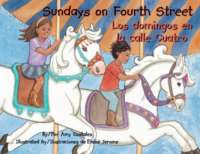
”My cousin Pepe combs my hair back just like his, and Aunt Pilar laughs. Then she slides her red lipstick across my lips, but Mama wipes it off because I’m too young. Mama puts on her new jeans, and Aunt Pilar polishes her high heels. Uncle Armando finishes washing his old car.” And then, a young girl and her family pile into the shiny car, grown-ups in the front, and kids in the back, and head to Fourth Street.Sundays spent on Fourth Street are magical, family outings that three young cousins eagerly anticipate. Strolling down Fourth Street with their parents, the children encounter a bustling wonderland filled with music, food, and fun. The cousins savor sharp bursts of flavor from mangos on a stick covered with lemon, chili and salt; delight in the sight of folk dancers spinning in the plaza; revel in rides and raffles at the church carnival; and yearn for clothes and toys they see in shop windows. While the children may not get the things that so often catch their attention, they can always look forward to more fun together next Sunday on Fourth Street. Based on real-life visits to Fourth Street in Santa Ana, California, author Amy Costales has written a story that pays homage to a special street and, more importantly, time spent with loved ones. Paired with Elaine Jerome’s colorful illustrations that depict lively street scenes, readers of all ages will enjoy Sundays on Fourth Street.
Numero Uno
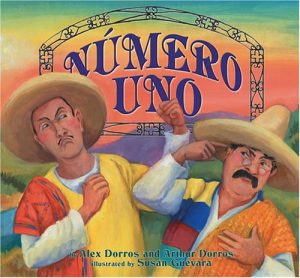 A bilingual picture book that will be #1 this spring! From a talented team, this hilarious tale of competition run amok is told with a sprinkling of Spanish and a heaping spoonful of charm. Which is better, brains or brawn? In a small village, Hercules is known for his great strength and Socrates for his keen intelligence. Whenever the villagers have a problem, they go to one or the other for help. Each man believes that he is the most important person in town. And the two fight about it constantly. Who, their neighbors wonder, will resolve the question that instigates all this bickering? The villagers realize they must settle the argument once and for all by finding out who is “número uno.” They devise a clever test, and Hercules and Socrates, each sure he will win, go along with it. The answer is a surprise for everyone “I came up with the idea for Número Uno in sixth grade when the class was asked to write fables. I thought that these two characters, one with outstanding intelligence and one with exceptional brawn, would together create an entertaining story. It could also carry a valuable lesson, as fables do. The story was originally set in China, but to me it is universal. We later decided to change to a Spanish-speaking setting, which I am more familiar with. “I grew up bilingual, speaking English and Spanish, and have visited many Latin American countries, including going to school there for a short while. I’m now sixteen years old and am enjoying living in Seattle. I spend much of my free time going to the nearby mountains (like Hercules and Socrates do in the book), in my case to snowboard. I also create my own stories through taking photographs, a few of which have now been published. I stay busy with playing baseball and going to high school. “As we wrote the book, the story stayed essentially as I originally had it, though we went through seemingly endless numbers of revisions and ended up changing details in the process. Writing a book with your dad is definitely not the easiest of tasks. At some points we reminded ourselves of the bickering characters in the story. Ultimately we were able to work together to create what I hope is a book you’ll enjoy.”—Alex Dorros on the creation of Número Uno with his father Arthur Dorros
A bilingual picture book that will be #1 this spring! From a talented team, this hilarious tale of competition run amok is told with a sprinkling of Spanish and a heaping spoonful of charm. Which is better, brains or brawn? In a small village, Hercules is known for his great strength and Socrates for his keen intelligence. Whenever the villagers have a problem, they go to one or the other for help. Each man believes that he is the most important person in town. And the two fight about it constantly. Who, their neighbors wonder, will resolve the question that instigates all this bickering? The villagers realize they must settle the argument once and for all by finding out who is “número uno.” They devise a clever test, and Hercules and Socrates, each sure he will win, go along with it. The answer is a surprise for everyone “I came up with the idea for Número Uno in sixth grade when the class was asked to write fables. I thought that these two characters, one with outstanding intelligence and one with exceptional brawn, would together create an entertaining story. It could also carry a valuable lesson, as fables do. The story was originally set in China, but to me it is universal. We later decided to change to a Spanish-speaking setting, which I am more familiar with. “I grew up bilingual, speaking English and Spanish, and have visited many Latin American countries, including going to school there for a short while. I’m now sixteen years old and am enjoying living in Seattle. I spend much of my free time going to the nearby mountains (like Hercules and Socrates do in the book), in my case to snowboard. I also create my own stories through taking photographs, a few of which have now been published. I stay busy with playing baseball and going to high school. “As we wrote the book, the story stayed essentially as I originally had it, though we went through seemingly endless numbers of revisions and ended up changing details in the process. Writing a book with your dad is definitely not the easiest of tasks. At some points we reminded ourselves of the bickering characters in the story. Ultimately we were able to work together to create what I hope is a book you’ll enjoy.”—Alex Dorros on the creation of Número Uno with his father Arthur Dorros
Here, Kitty, Kitty!/Ven, gatita, ven! (My Family: Mi Familia)
Our new kitty likes to hide. A nuestra nueva gatita le gusta esconderse. She hides under the table, Se esconde debajo de la mesa, inside a flowerpot, dentro de una maceta and behind the curtains. Y detrás de las cortinas. We call out to her, La llamamos, pero . . . but will she ever come close enough to pet? ¿se acercará lo suficiente como para acariciarla? Here, kitty, kitty! ¡Ven, gatita, ven! This third book in Pat Mora’s bilingual My Family/Mi familia series will delight children with its mischievous kitty, playful illustrations, and engaging story. Este tercer libro de la serie bilingüe My Family/Mi familia de Pat Mora entretendrá a los niños con una gatita traviesa, ilustraciones graciosas y una historia encantadora.
The Piñata Maker / El Piñatero
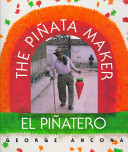
Told in both English and Spanish by award-winning author-photographer George Ancona, The Pinata Maker/El pinatero documents this traditional Latin American artform and includes a note on how to make pinatas at home. Set in Mexico.
The Eyes Of The Weaver: Los Ojos Del Tejedor
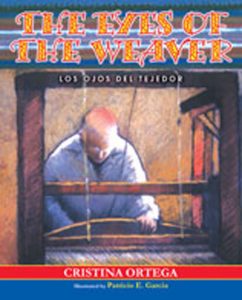 Cristina Ortega is the granddaughter of Juan Melquiades Ortega, a master weaver of northern New Mexico’s Chimayó Valley. Chimayó’s roots are in early Spanish Colonial times and has long been famous for its unique weavings. Juan M. Ortega was taught to weave by his father in the early days when weavers sheared their own sheep and spun and dyed the wool for their blankets. El Tejedor (The Weaver) continued weaving until he was one hundred years old, when his eyesight failed him. In The Eyes of the Weaver, Cristina shares her memories of visits when she was ten years old with Grandpa in the village of Chimayó, where he taught her how to weave. She also recalls how Grandma helped her husband choose color combinations for his Chimayó blankets. It was during these visits that Cristina learned how important it is for a child to listen to and learn from his or her relatives.Some of Juan M. Ortega’s weavings and tools of the trade have been included in the exhibit, “American Encounters,” at the National Museum of American History, Smithsonian Institution, in Washington, D.C.Reading level: 10 years and up
Cristina Ortega is the granddaughter of Juan Melquiades Ortega, a master weaver of northern New Mexico’s Chimayó Valley. Chimayó’s roots are in early Spanish Colonial times and has long been famous for its unique weavings. Juan M. Ortega was taught to weave by his father in the early days when weavers sheared their own sheep and spun and dyed the wool for their blankets. El Tejedor (The Weaver) continued weaving until he was one hundred years old, when his eyesight failed him. In The Eyes of the Weaver, Cristina shares her memories of visits when she was ten years old with Grandpa in the village of Chimayó, where he taught her how to weave. She also recalls how Grandma helped her husband choose color combinations for his Chimayó blankets. It was during these visits that Cristina learned how important it is for a child to listen to and learn from his or her relatives.Some of Juan M. Ortega’s weavings and tools of the trade have been included in the exhibit, “American Encounters,” at the National Museum of American History, Smithsonian Institution, in Washington, D.C.Reading level: 10 years and up
Triple Banana Split Boy / El Nino Goloso
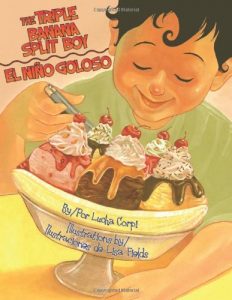 ”How come you can have sweets and I can’t?” Enrique asks the hummingbirds as they flutter over the flowers in the garden. His craving for sugar is getting out of control, and his father has forbidden him to eat anything sweet. Enrique’s birthday is coming up and he won’t be allowed to help his grandma with her baking. It’s not fair! Enrique’s cravings multiply by the minute. Even numbers in his math book start to look like yummy desserts. His life is over! The next day, though, he comes up with an ingenious plan to outwit his father. Unfortunately, his mother soon catches on. But she has a plan of her own. On Mondays and Fridays only, after school, Enrique may have any dessert he likes, but none during the rest of the week. What a sweet deal!On his first outing with his mother, Enrique orders a huge triple banana split, with strawberry, chocolate and vanilla scoops of ice cream, nuts, sprinkles and chocolate syrup. Later that night, Enrique’s stomach aches, and El Coco, a fearsome creature with a huge mouth and sticky hair, haunts his dreams. Enrique’s mother wonders if he will ever learn to eat in moderation. Will he be able to bake with Grandma? And what about having a special treat on his birthday? Lucha Corpi’s poetic prose is combined with Lisa Field’s enticing illustrations in this engaging story that will resonate with kids and their parents as they struggle to balance healthy eating habits with the natural desire for sweets.
”How come you can have sweets and I can’t?” Enrique asks the hummingbirds as they flutter over the flowers in the garden. His craving for sugar is getting out of control, and his father has forbidden him to eat anything sweet. Enrique’s birthday is coming up and he won’t be allowed to help his grandma with her baking. It’s not fair! Enrique’s cravings multiply by the minute. Even numbers in his math book start to look like yummy desserts. His life is over! The next day, though, he comes up with an ingenious plan to outwit his father. Unfortunately, his mother soon catches on. But she has a plan of her own. On Mondays and Fridays only, after school, Enrique may have any dessert he likes, but none during the rest of the week. What a sweet deal!On his first outing with his mother, Enrique orders a huge triple banana split, with strawberry, chocolate and vanilla scoops of ice cream, nuts, sprinkles and chocolate syrup. Later that night, Enrique’s stomach aches, and El Coco, a fearsome creature with a huge mouth and sticky hair, haunts his dreams. Enrique’s mother wonders if he will ever learn to eat in moderation. Will he be able to bake with Grandma? And what about having a special treat on his birthday? Lucha Corpi’s poetic prose is combined with Lisa Field’s enticing illustrations in this engaging story that will resonate with kids and their parents as they struggle to balance healthy eating habits with the natural desire for sweets.
Pablo Remembers
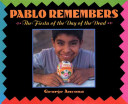
From October 31 to November 2, people in Mexico celebrate the festival of el Dia de Los Muertos, the Day of the Dead. This photodocumentary follows Pablo and his family as they prepare to honor the memory of Pablo’s grandmother. Ancona’s photographs catch the affirmation of life that fills the Mexican festival arising from both Aztec and Christian customs honoring the dead.
I’m Just Like My Mom; I’m Just Like My Dad/ Me parezco tanto a mi mama; Me parez
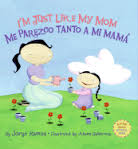
I’m just like my mom.
Me parezco tanto a mi mamá.
I’m just like my dad.
Me parezco tanto a mi papá.
With Akemi Gutiérrez’s charming illustrations, renowned journalist Jorge Ramos explores the many ways in which all children are just like their parents—in two languages!
Junto con las simpáticas ilustraciones de Akemi Gutiérrez, el respetado periodista Jorge Ramos explora las varias maneras en que los hijos se parecen a sus padres. ¡Y lo hace en dos idiomas!
